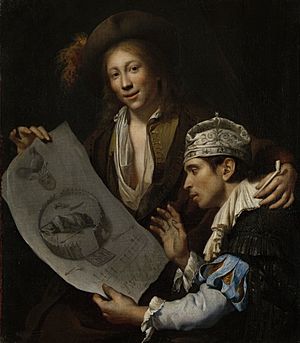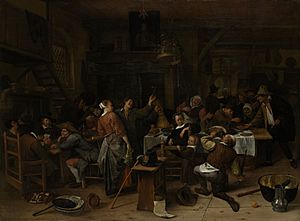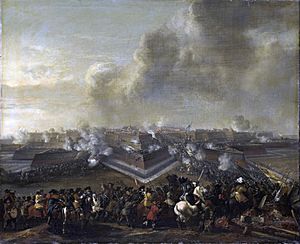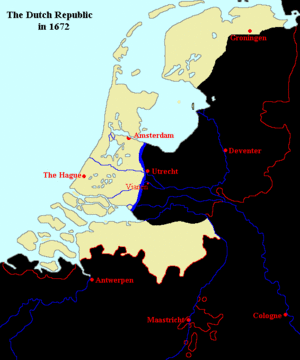Rampjaar facts for kids

The year 1672 in Dutch history is known as the Rampjaar (pronounced "Ramp-yar"), which means Disaster Year. It was a very difficult time for the Dutch Republic. In May 1672, France, helped by Münster and Cologne, attacked the Netherlands. They almost took over the entire country. At the same time, England tried to block Dutch ships at sea, but they failed after the Battle of Solebay.
People in the Netherlands used a saying that year: the Dutch people were "irrational," their government was "distraught," and the country was "beyond saving." Many cities in the coastal areas like Holland, Zealand, and Frisia saw big political changes. Supporters of the House of Orange took control of city governments. This ended the rule of the republican government led by Grand Pensionary Johan de Witt.
By late July, the Dutch situation got better. They received help from the Holy Roman Empire, Brandenburg-Prussia, and Spain. England, Cologne, and Münster later made peace with the Dutch in 1674. French troops then left most of the Dutch Republic. The war continued in other areas until 1678. The final peace agreement, the Peace of Nijmegen, left the Dutch Republic safe.
Contents
Dutch Politics Before the Disaster

For many years, there was tension in the Netherlands. Some people wanted the country to be ruled by wealthy citizens called "regents." Others wanted a leader from the House of Orange, like a Prince. These tensions grew in 1650 when William II, Prince of Orange, tried to take over Amsterdam. This city was a stronghold for the regents.
After William II died, the republican party (the regents) came back into power. They decided not to appoint a new leader from the House of Orange. They believed that having a single supreme leader would harm "True Liberty." Johan de Witt became the Grand Pensionary of Holland, leading the most important province.
The regents' takeover faced some protests from Orange supporters. However, the economy was doing well, and there was peace. So, the Orange supporters had little chance to remove the government. To keep everyone happy, and because it was good for business, the Dutch regents tried to keep peace in Europe.
Dealing with Other Countries
When the Dutch Republic fought for its independence from Spain, it was friends with France and England. In 1648, the Dutch made peace with Austria and Spain. France, however, kept fighting Spain until 1659. As part of that peace, the French King Louis XIV married Maria Theresa of Spain. She was supposed to give up her claim to the Spanish throne for a large payment, but Spain never paid it.
In the 1650s and 1660s, problems grew between Dutch and English trade. The First Anglo-Dutch War happened, and England won. In a secret part of the peace treaty, Holland promised not to appoint a leader from the House of Orange. This was because Oliver Cromwell, England's leader, didn't like the House of Orange. This agreement made the pro-Orange group in the Netherlands very angry.
When Charles II of England became king of England in 1660, he canceled that secret agreement. But he still kept parts of the peace treaty that hurt Dutch trade.
Another war, the Second Anglo-Dutch War, started when England tried to take over Dutch trade and colonies. After the first war, Johan de Witt had made the Dutch navy much stronger. With their new fleet and help from France, the Dutch defeated the English at sea. England and Münster were forced to make peace.
After the Spanish King Philip IV died, Louis XIV claimed parts of the Spanish Netherlands for his wife. This was a problem for the Dutch Republic. They preferred to have a weak country as their neighbor to the south, not a strong France.
Because of this, Johan de Witt formed an alliance with England and Sweden. This was called the Triple Alliance. They secretly agreed to use force if Louis XIV didn't make a deal with Spain.
Changing Alliances
France did make peace with Spain. But the secret parts of the Triple Alliance became public. Louis XIV felt insulted by the Dutch, believing they had broken their word. Right after the peace deal, France worked to isolate the Dutch Republic. Sweden and Münster were quickly bribed by France.
The English public didn't trust Louis XIV. But the English King, Charles II, thought a war with the Dutch would be good for him. He hoped that if the Dutch lost, their republican government would fall. Then, his nephew, William III of Orange, could take power. A war would also be a chance to hurt Dutch trade. Louis also promised Charles a lot of money, so Charles wouldn't need to ask the English parliament for funds.
In 1670, France and England signed a secret agreement called the Treaty of Dover.
Heading Towards War
The Dutch knew that England and France were talking, but they didn't know the details. Johan de Witt hoped that the English public would not want a war with another Protestant country. He tried to improve relations with France. However, they couldn't agree on the future of the Spanish Netherlands. France wanted the Rhine river as its border, which meant taking over the Spanish Netherlands. The Dutch felt threatened by France's plans.
The Dutch strengthened their navy again. But they didn't prepare their army enough because they lacked money. The regents also didn't fully trust the army, as it had often supported the Orange party. As war seemed more likely, pressure grew on the Dutch government to appoint William III as their military leader. In February 1672, Johan de Witt finally agreed to make William Captain-General for one war.
The War Begins
On March 12, 1672, English ships attacked a Dutch trade convoy. France, the Electorate of Cologne, and the Bishopric of Münster declared war in April. In June, Louis XIV's army invaded the Netherlands from the east.
The French easily won a battle at the IJssel river. The city of Groenlo was taken. Suddenly, the whole Dutch Republic seemed open to the French. Panic spread in cities like Holland, Zeeland, and Utrecht. People from the lower and middle classes protested against the government. They demanded that the Prince be appointed leader and that those responsible for the war be punished. Johan de Witt and others resigned, and the regents' government fell. Supporters of William III took over.
The De Witt Brothers
People were still very angry, and the military situation seemed hopeless. This led to a search for people to blame. In August, Cornelis de Witt, Johan's brother, was put in prison in The Hague. He was suspected of treason. When Johan de Witt visited his brother, the small group of guards was sent away. A large crowd gathered around the prison, demanding punishment for the brothers. The prison was stormed by angry citizens. The De Witt brothers were killed by the angry crowd. Some historians believe that this was part of a plan involving William III, but there is no direct proof.
The Waterline Defense

The French army had reached Utrecht. At this point, talks began. Louis XIV and Charles II of England wanted William to become a ruler of a small Dutch state. Louis stopped his army to let the Orange supporters take over Holland and make a deal with him. He offered peace if the Dutch gave up southern forts, allowed religious freedom for Catholics, and paid six million guilders. Or, he would keep his current conquests and demand sixteen million guilders.
These demands, especially the money, made the public even angrier. The Dutch people changed from feeling defeated to being determined to fight back.
While talks were happening, the French failed to stop the Dutch from flooding the Dutch Waterline. This was a defense system where large areas of land were flooded to create a barrier of water and mud. Before the French understood how important this defense was, William III's small army moved behind it. The French advance was stopped by this impassable barrier.
The Dutch had other successes too. Their fleet, led by Admiral Michiel de Ruyter, had already beaten the English and French fleets at the Battle of Solebay. On August 28, 1672, the German Bishop of Münster stopped his attack on Groningen. This event is still celebrated in Groningen every year.
On the diplomatic side, the Holy Roman Empire and Spain joined the Netherlands. In 1673, a Dutch army captured Bonn. This forced the French to leave most of the Dutch Republic. England, Münster, and Cologne made peace in 1674. The French continued fighting until 1678.
Long-Term Effects
The experience of the Rampjaar greatly influenced how the Dutch dealt with other countries. William III saw it as his life's mission to protect the Netherlands and Europe from France's growing power. In all of Louis XIV's future wars, the Dutch would support his enemies.
In 1688, when England had a king who seemed to side with France, the Dutch used all their resources to invade Britain. They overthrew the Catholic Stuart Dynasty in what is known as the Glorious Revolution. This was a huge historical event. It was a risky move, but after the Rampjaar, the Dutch saw a Catholic and French-controlled Britain as a deadly threat to their own country. In England, public opinion was already turning against France, and the 1672 war sped this up.
The Dutch economy never fully recovered from the severe crisis of the Rampjaar. Even though the Dutch Golden Age is sometimes said to have continued until the end of the century, the art market was badly affected. For example, the famous painter Jan Vermeer could not sell his work after this time. Leading sea painters, Willem van de Velde the Elder and his son Willem II, moved to London and never came back.
See also
- Annus horribilis
- Castle Amerongen, a castle burned by the French in 1673
- List of Dutch structures damaged by the French (1672–1673)


